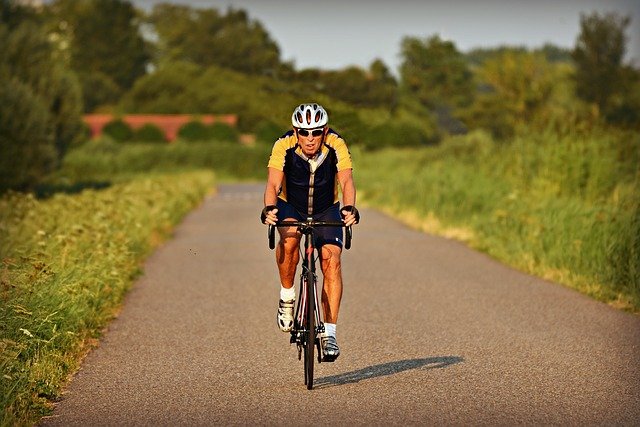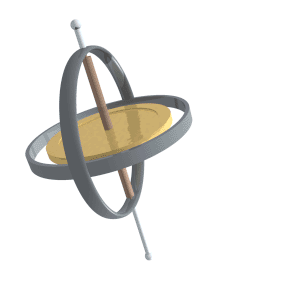A bike's stability is not as easy as it looks
After one or two falls we finally master the art of riding bicycles and often can't wait for the next school day to display our skill of riding to our friends. Riding a bicycle is easy, but have we ever paused long enough to understand how a bicycle achieves its stability and upright stay with little assistance from the rider?

Boneshaker. Image credits: By MabelAmber CC0 Creative Commons from Pixabay, Link]
It is a feat that the bicycle achieved for more than two centuries now. A hilarious scene in the 1949 French comedy Jour de fête, The Big Day in English, shows the lead actor Jacques Tati who played the role of an inept mailman chase his bicycle downhill with the bike remaining upright with no rider on it. You can watch the clip of the funny scene on youtube here.
The self-stabilisation in a bicycle is nothing short of a physics wonder. The idea that a two-wheel device is capable of being stable or even adjusting the stability so as to balance and even to do so with no one on it is almost akin to a magic. Well, the brilliant author and futurist, Mr Arthur C Clark, famously said that an advanced technology blurs the line between reality and magic.
Any sufficiently advanced technology is indistinguishable from magic. Wikipedia: Clarke's three laws.

Boneshaker. Image credits: By Daderot Public Domain from Wikipedia Commons, Link]
The bicycle though simple, had come a long way. From the 1860s Boneshaker, due to both the body and tire made of iron which makes for a bone-jarring feel when you ride one, to the modern bicycle we have today. You will agree that that technology had sufficiently advanced and evolved with time.
There is some hypothesis as to the reason a bicycle can remain upright. One of such is the gyroscopic effect.
A gyroscope is a metal wheel that is fixed on an axle, the wheel and axle combo is secured on a metal frame which allows the wheel to rotate freely when pushed. Any attempt to stand the gyroscope on its end when the wheel is stationary will remain unsuccessfully as it will keel over. But a wonder comes to light if you spin the wheel and stand it, and just as the gif shows, it will freely stand and rotate.

A spinning gyroscope. Image credits: By LucasVBPublic Domain from Wikipedia Commons, Link]
It will continue to rotate and will even resist any change in its orientation as long as it spins. If you are to lift up one end of a gyroscope by a thread, the other end will appear to hold steady as if held by an invisible hand. The rapid spinning bicycle wheel, or most wheel rotating around an axle, behaves like a gyroscope.
There is angular momentum in a rotating bicycle wheel, an inherent characteristic of the rotational speed and the mass distribution of the bicycle which includes the mass of the wheel. If you look at various bicycle design, you will realise that there is the concentration of mass around the wheel's rim. This design is to give an added angular momentum at any specific speed.
The gyroscope ability to remain in its position makes it an excellent tool as a navigation tool in aircraft and in space-exploring vehicles. In simple terms, this gyroscopic effect on a bicycle wheel ensures that a spinning wheel stays spinning and remain positioned to their spin axes.
The school of thought who believes that it is the gyroscopic effect that keeps the bicycle from keeling over did miss a couple of things. While the effects may work for the motorcyclists with their heavy, fast-spinning wheels, the grandfather taking his bicycle for an evening stroll may experience very little of such an effect as the wheels may not spin as fast and the bicycle wheels are also very light in weight.
If you also check how many bruises you acquired when learning how to ride a bicycle, you will realise that left for the gyroscopic effect, all you need is to push the bike and jump and be on your merry way.

A spinning gyroscope. Image credits: By Rishiyur1Public Domain from Wikipedia Commons, Link]
The second long-held belief as to the reason we have an upright bicycle is the castor or caster effect.
The angle θ shows the caster angle. It is expressed in degrees and shows the angular displacement which is present between the vertical axis of the wheel (denoted by the grey perpendicular line) and the steering axis which is shown in the red dotted line.
A caster angle θ is positive if the steering axis (red dotted line) slopes from the rear of the bicycle (machine) to the front, and negative if the steering axis slopes from the front to the rear of the bicycle or machine.

If the front of the bicycle is on the left side of the image, this is a positive caster angle. Image credits: By KtimsPublic Domain from Wikipedia Commons, Link]
But bicycle dynamic expert like Arend L. Schwab of the Delft University of Technology in the Netherlands has so far stated that those two phenomena are not what a bicycle needs to be self-stable. The researchers published a science paper titled A Bicycle Can Be Self-Stable Without Gyroscopic or Caster Effects in 2011. The paper demonstrates that the two effects are not necessary to bike's stability as they designed a riderless bike that lacks both attributes that can steer itself and even auto-corrects itself from a nudge while in motion.
In their research they found that other various design parameters such s the mass distribution, the axis in steer tilt all affect the stability in complex ways. It is still a work in progress to ascertain other things that will help increase the rider's safety. The majority of fatalities/accidents in cycling occurs when a rider loses stability and not necessarily when they run into objects.
References
- Your bike's secret to staying upright is actually a mystery
- The Physics of the Riderless Bicycle
- Gyroscope
- Balancing act: Why don't bikes just fall over?
- Bicycle Wheel Gyro
- A Bicycle Can Be Self-Stable Without Gyroscopic or Caster Effects
If you write STEM (Science, Technology, Engineering, and Mathematics) related posts, consider joining #steemSTEM on discord here. If from Nigeria, there may be need to include the #stemng tag in your post. You can visit this blog by @stemng for more details. You can also check this blog post by @steemstem here and this guidelines here for help on how to be a member of @steemstem. Please also check this blog post from @steemstem on proper use of images devoid of copyright issues here
Would you like to delegate to the @steemstem? Here is a link below
50 SP | 100SP | 500SP | 1,000SP | 5,000SP | 10,000SP | 50,000SP

Hello @greenrun
Certainly an interesting discussion on the secrets being our ability to ride a bicycles. I have actually wondered about this before but it always escaped my mind to research on this.
The gyroscope explanation given is well understood. Even while reading this, I knew gyroscope won't be the only reason responsible for this phenomenon. Then you mentioned the castor effect which also helped in no small measure to buttress facts. Thanks for sharing
@eurogee
I have always known there's more to biking than meets the eye.
Posted using Partiko Android
It amazes me how you put together this wonderful piece. Honestly you are a genuis.
When you said this, i recalled my first experience to ride on the bicycle.
This is through. I recalled i fell so many times when learning how to ride the bicycle not because i encountered an obstacle but because i lost stability.
Thank you @greenrun for the post.
I doubt that I'm a genius :)
All the same thank you for thinking so highly of me :D
To everything in life, science will always have its own cut and ways of explaining them. This is just as interesting as the concept is.
You rightly pointed the major factor - stability of the rider. I knew how many times i fell when i started learning how to ride that iron.
It's truly an iron :) First time riding is an exhilarating experience.
Hey. I am physicist and rider. Always i thought angular momentum can't be enough for stability. It's very minor force for that mass.
Unfortunately i never made search as you made.
I am reading the artcile ("A bicycle can be self-stable without gyroscopic or caster effects") now.
I don't like people when they are sure of everything. Many physicsts sure that they know how bike works :))
This is great post. Thank you.
Oh, that's awesome. You'd find the article pretty interesting.
Posted using Partiko Android
Going through this write up has made me realize the reason why i was able to easily remove hands while riding a bicycle back then
The expert riders can easily do the hands off stunt.
This is a very good one from you sir, but its sad I can't even ride a bicycle.. Lol
Well illustrated and defined
What did you ride as a child? A car?
Lol... Tyres and something called we called "boris" then, I dont know if you've heard of that before
I have always wondered how people ride a bicycle, for me it was impossible skill to tackle... At the end I learned how to do it, as long as I can go straight and not make any turns :D
And why on Earth would anyone do it? It's uncomfortable and unsafe :P
Crazy people...
Riding bicycle is super fun. You don't really have to take much risk by riding around hairpin bends. Though once you master it, it becomes more fun.
Am not happy to say it here that i still could'nt stand on a bicycle. Even while in my secondary school days my friends make jest of me. There was an occasion they helped me with the bicycle and left me by myself on it. I guess you can understand what happened next. (A great fall). I have heard about the gyroscopic effect before probably in my physics class but never connect it with same principle for bicycle.
Stability was my problem then. So i think i will agree with the last paragraph and the mass distribution effect.
I think the castor effect also explain better. Thanks for this information @greenrun
Science is all connected.
Hey Green, how great seeing a post from you on my feed today :) And this is a curious one indeed! You are right, I never contemplated about the complexity involved in keeping a bike stable and upright! I have so many good and bad memories involving bicycles from when I was a child 😅
Well, as always, I enjoyed very much the historical part of your post. I enjoy even more the history part of posts that are about physics 😉 I never stopped to think about how old 'the bicycle' is, so to realize it dates back from the mid 1800's and is still going strong makes me think that it is indeed a great feat!
That is a beautiful quote by Mr Arthur C Clark that you shared here Green. Oh, I watched the funny scene too. That poor postman! 😆
Lots of love to you and all the best :)
My biking story could make a book :)
It was as crazy as it was hilarious.
Posted using Partiko Android
Hello mr greenrun, this is some serious research.. am not sure i have fully grasped it all but maybe another go through will get me there. Lol i still dont know how to ride a bike anyway and am not sure i would want to right now. But i manage for some reason to balance it just moving straight and not turning
Ok, give it another read. I thought everybody knows how to ride a bicycle :)
Not everyone. Am so sad 😅
Really? Oh, thought everyone can :)